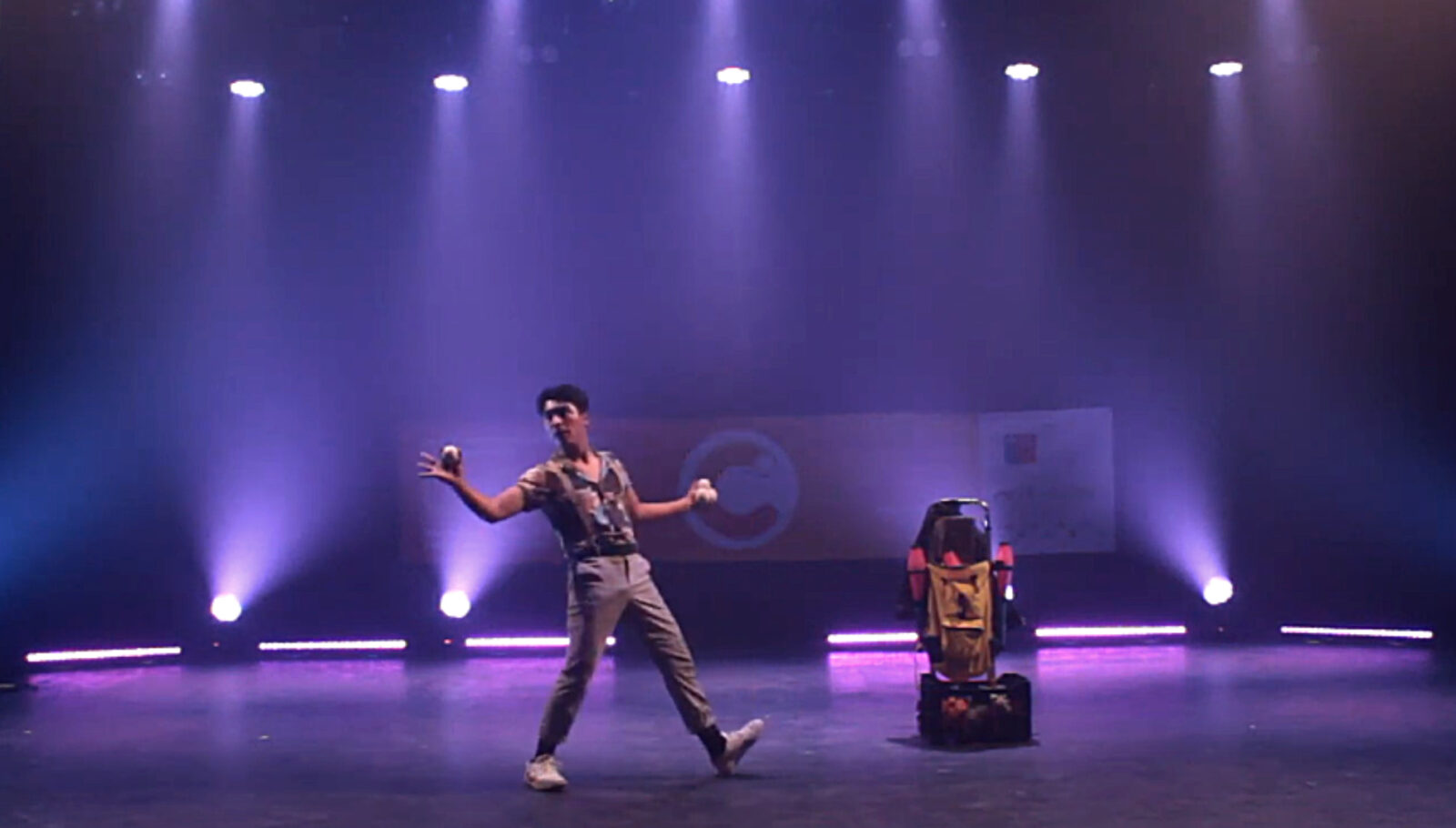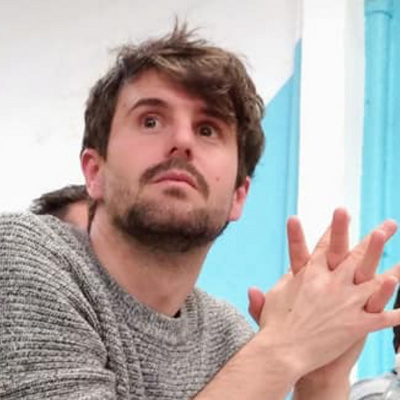Sise, the Juggler
All the world’s a stage… and whether performing at a local festival, in international competitions, or at a traffic light in Puerto Montt, a great juggler will fit in anywhere. Miguel Manzano of the Esta Pasando project hopes to bring one talented young Chilean juggler into the limelight.
Está Pasando continues its journey of mapping circus culture in Latin America, and this time, the latest stop brings us back to Chile. I say “latest” because as of writing these lines, we are currently in Argentina. Our journey continues, and with every step we take, new stories, adventures, and diverse interpretations of Latin American circus culture emerge.
Today, I’m going to share the story of someone you might already know. If you’re one of those people who follow all the content published by CircusTalk, you probably do. Last June, we released a six-episode documentary series in which we examined the phenomenon of juggling in Chile, attempting to answer the question: “Why is there such a widespread juggling culture in a place like Chile?” One of the voices featured in this series was our protagonist today: Sise.
In this article, I won’t delve too deeply into the Chilean juggling phenomenon, but if it piques your interest and you missed it, I highly recommend reading the interview we conducted with Marcelo Troncoso, the director of the documentary.
SURCIRCO FESTIVAL
On February 23rd, we arrived at the SUR CIRCO Festival in Frutillar, in the south of Chile. That festival and the circus community that organizes it deserve their own story. In fact, I’m going to share it with you before we continue. The truth is, I write these articles because Está Pasando’s objective is to shed light on and celebrate the circus stories of Latin America, so why not?
If you’re one of those who follow all of CircusTalk’s social media posts, then you probably joined me during the Instagram Takeover we did during the event. And if not, I recommend you take a look because it was a beautiful festival.
Like many events in this part of the world, the SUR CIRCO Festival is self-managed. The concept of “self-management” is directly related to the economic culture of each country. In Latin America, a “self-managed” event means that the people organizing it receive no financial compensation, and they do it assuming that it’s very likely not to be profitable. In the best cases, they won’t lose their own invested money. In other words, they do it simply because they believe the world is a better place with that event in existence.
It’s worth noting a peculiarity of this place: there are two “Frutillars.” Frutillar Alto is, where the majority of the population lives, predominantly from the lower class. And then there’s Frutillar Bajo, by the lake in front of the volcano, with beautiful little houses that seem to be imported directly from Germany. Crowning the lakeshore is El Teatro del Lago, an internationally recognized symbol of High Culture in this part of the country. Everyone in Chile has heard of El Teatro del Lago. Few people from Frutillar Alto have ever set foot inside.
So, where does circus fit into all of this? Well, High Culture is created and consumed by high-class individuals. This same upper class often has the capital to invest and its own vision of a better world to aspire to. This often translates into them creating foundations that support culture, provide opportunities for the less fortunate, or offer tax deductions. Each social class has its own hobbies.
The thing is, the Mustakis Foundation, founded by a Greek-origin family that prospered in Chile, has numerous regional development projects. Years ago, they embraced an experimental circus program: Circo Frutillar. What started as a small, anecdotal activity proved its potential and has become one of the cultural landmarks of the Los Lagos Region. At first, bringing circus artists and trainers from other parts of the country was a significant challenge. However, they gradually gathered a group of circus artists who now reside in the town and are trainers, managers, artists, and neighbors of Frutillar Alto.
This program, which began in 2014, has grown very organically and since branched out in the region, giving rise to several local artistic groups like La Maroma, a professional circus company composed of teachers and former students of the social circus program, and Aéreas Frutillar, a collective of young female circus artists, also made up of former participants in the program.
Last year, these groups, along with other local collectives, decided to take a step forward and organize the SUR CIRCO Festival. A week filled with circus performances from all over Chile and even Argentina, delighting the people of Frutillar (Alto and Bajo). It was a tremendous success. So much so that they decided to do it again next year, with more institutional support and more proposals. And not content with that, a few weeks ago, they gathered the courage to inaugurate their own cultural space: El Galpón, a space that had been rented by the Foundation until then. Imagine how much that circus seed has grown. The first underground cultural center in the area, the counterbalance to Teatro del Lago.
For me, this collective is one of the great examples of how circus transforms the community, the territory, and people’s lives. Here, the key ingredients came together: a foundation that funded a circus project for at-risk children, a manager who knew how to capture talent and mobilize it, a series of committed people eager to share their circus knowledge, and a fertile environment where culture was destined only for the wealthy elite. And that resulted in an independent Festival from the Foundation that set all of this in motion. A festival formed not only by circus people but also includes other local artistic expressions. Circus, as so often, acts as a catalyst for the arts and communities.
I didn’t know any of this, and in fact, I wasn’t planning to travel to Southern Chile. Está Pasando’s original plan was to go from Chile to Peru, Ecuador, and finish in Colombia. A year-long project.
But life can’t always be planned. In December, there was an attempted coup in Peru while we were still in Valparaíso. That led to the closure of land borders with Chile, and we decided we couldn’t head north across the Atacama Desert. So, to bide our time until the borders reopened, we considered heading south to explore this new circus festival that was generating a lot of buzz.
And that was the first time I saw Esteban Almonacid, “Sise” to his friends. It was like this:
I’m not used to being so amazed by a juggling show. My reaction was, in fact, the origin of this article.
MY TRUE INTENTIONS
The festival continued, and I didn’t see that young force of nature named Sise again. We barely had time to exchange a few words that day. He remained just another memory.
But fortunately, at that moment, we were working on the juggling documentary with Marcelo, who already had someone on his list to talk about Sport Juggling in Chile. However, one day, while we were in Chiloé, Iskándara, my travel companion, suggested that we interview Sise. It made a lot of sense: he was from the new generation (although he considered himself already part of the old school at 22); he was from an area far from the country’s epicenter, which added more representation to the documentary; he had been the Chilean representative in the last world juggling competition organized by the World Juggling Federation, finishing second; and last but not least, at his young age, he had broken 10 world records and won the Latin American regional competition organized by the International Jugglers’ Association.
Seen in this light, it was obvious that he was the one we should interview. I discussed it with Marcelo, and he thought it was ideal. We contacted Sise and decided to pay him a visit in Puerto Montt, his city, on our way back from Chiloé.
What we found was one of the greatest living juggling geniuses performing an impressive routine at a traffic light, with a banner for his show, just in case any talent scout happened to pass by the outskirts of Puerto Montt. Take a look at the first few seconds of his episode to see the real scene with your own eyes:
I want to be honest with you. For me, as a circus artist and an architect fascinated by urban planning, the traffic light is the stage of the 21st century born from the 20th-century city. In European cities, we have squares and parks, while in America, you have avenues, intersections, and traffic lights. It’s one minute of bored audience, distributed in an inefficient but constant flow, inside very dangerous machines that take us from one task to the next. It’s an opportunity to bring art where no one expects it (which I believe is where its beauty lies, precisely). A stage that emerges from traffic rules. Like a lichen that appears in the desert and feeds on it to take root all over the world.
Then we interviewed him, and I was amazed by Esteban’s honesty and maturity. The hard work, the passion with which he spoke. At the same time, his humility. He told me, “If I had dedicated all the time I spent breaking records to create an artistic show, I could already be making money.” But his show is already art, and he’s only 22 years old. He started juggling at 12, and, as a mutual friend told me, they nicknamed him “Sise” at juggling conventions because when they asked if he could do a trick, he would answer, “Si sé,” which means “I know” in English. Now, he is the Chilean ambassador to the World Juggling Federation, “directly appointed by Jason Garfield,” as he proudly likes to say.
I highly doubt any talent scout will ever pass by his traffic light on the outskirts of Puerto Montt.
But I did pass by. And I saw something like this:
And, you know? For Sise, I am the closest thing to a talent scout because I have access to the world’s largest circus platform, which gathers all the talent scouts for me. And for Sise.
I think you can see where I’m going with this. In case you have any doubts, here’s his professional profile on CircusTalk. Adolfo Esteban Almonacid Cardenas, “Sise” to his friends, will be delighted to receive that offer that takes him off the traffic light and puts him in your circus tent, so people can applaud like I did when I saw him for the first time.
Photographs in this article belong to Esta Pasando. Main image: Sise in the 2022 IRC competition show (screenshot), via DelarutA and IJA video....
Do you have a story to share? Submit your news story, article or press release.





